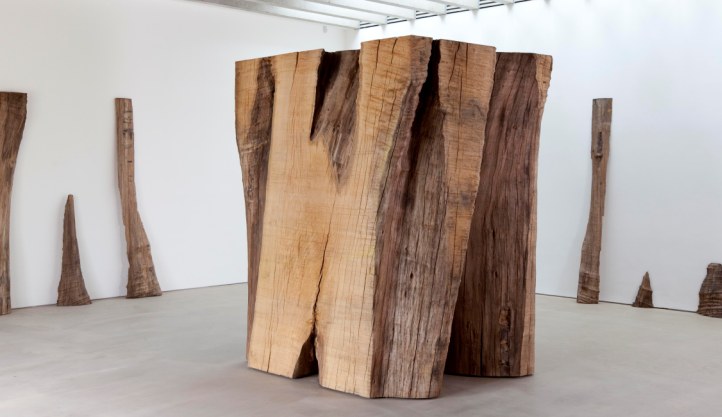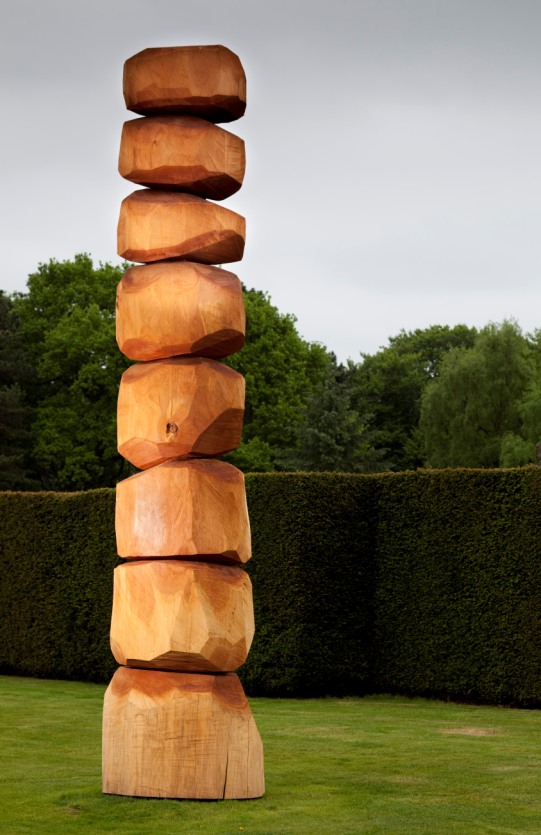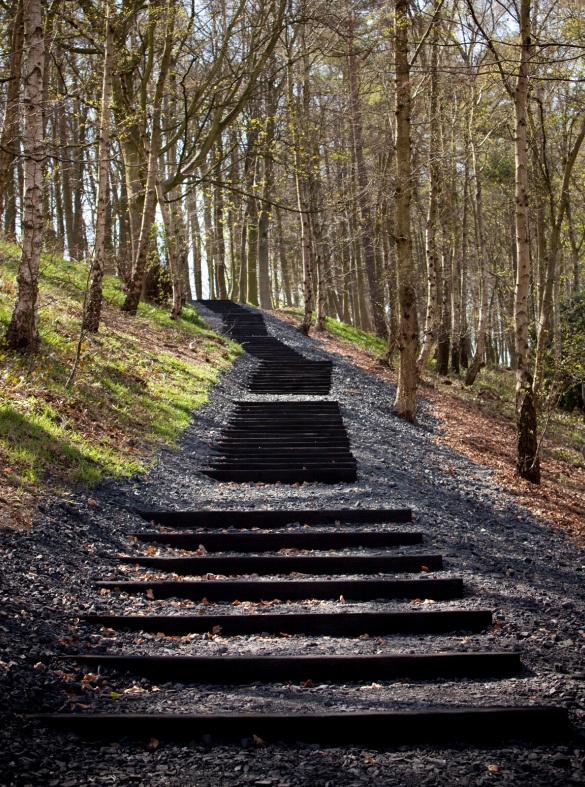David Nash, Yorkshire Sculpture Park | reviews, news & interviews
David Nash, Yorkshire Sculpture Park
David Nash, Yorkshire Sculpture Park
A spellbinding 40-year career retrospective of the sculptor who works in wood
Saturday, 29 May 2010
Wood is a mysterious substance. We do not make it, it makes itself. It is useful to us, alive and dead. Without it, our history would not be the same. But it is so ever-present, so much a part of that history, that we rarely see the wood for the trees. David Nash has seen both the wood and the trees for years. To him, wood is life.
 The opening of this show says it all. Outside the first gallery is a huge eucalyptus, split into three by the sculptor. (Nash only works with “found” wood – from dead or dying trees, offcuts from tree-surgeons, or from wood yards – "wood quarries", he calls them.) Inside, the regular information desk has been replaced by a huge chunk of the same tree, and is surrounded by more raw wood which will crack and change over the year of the exhibition: it has been a thousand years growing; now it will alter as the visitors watch. Wood is a process, not a product.
The opening of this show says it all. Outside the first gallery is a huge eucalyptus, split into three by the sculptor. (Nash only works with “found” wood – from dead or dying trees, offcuts from tree-surgeons, or from wood yards – "wood quarries", he calls them.) Inside, the regular information desk has been replaced by a huge chunk of the same tree, and is surrounded by more raw wood which will crack and change over the year of the exhibition: it has been a thousand years growing; now it will alter as the visitors watch. Wood is a process, not a product.Inside the gallery, the mammoth trunk is countered by Oculus Block (pictured above right), a huge bole of a tree-root and trunk, some 12 tons, 2.4 metres across and three metres high, four trees that grew and, at some point over their centuries of life, fused together. This is framed by pieces of bark, shaped and leaning against the wall, framing the trunk as they framed and protected it in life. Two Vessels, two long canoe-shaped pieces of oak, scorched black along the prows and the hollowed interiors - blade-sharp in their forward motion - are transporters of living wood, thrusting into space.
 Outside, the totemic Red Column (pictured left), satisfyingly rounded and lush despite its towering upward thrust, sits next to Black Dome, a series of graduated black pyramids lurking by a hedge, vanishing and reappearing as the light changes. Black Ball (main picture), at the top of the hill, looks like an alien spaceship entirely at home in Yorkshire. Almost visible across the valley is the extraordinary permanent piece commissioned by the park: Oxley Bank Black Steps (pictured below right) carves gently into the hillside, 71 charred oak steps embedded in a coal drift that echoes a drift of bluebells alongside. The dual organic nature of the steps, wood and coal, recapitulates the history of the local countryside and man’s dependency on the natural world: “man-made” could not exist without “nature-made” first.
Outside, the totemic Red Column (pictured left), satisfyingly rounded and lush despite its towering upward thrust, sits next to Black Dome, a series of graduated black pyramids lurking by a hedge, vanishing and reappearing as the light changes. Black Ball (main picture), at the top of the hill, looks like an alien spaceship entirely at home in Yorkshire. Almost visible across the valley is the extraordinary permanent piece commissioned by the park: Oxley Bank Black Steps (pictured below right) carves gently into the hillside, 71 charred oak steps embedded in a coal drift that echoes a drift of bluebells alongside. The dual organic nature of the steps, wood and coal, recapitulates the history of the local countryside and man’s dependency on the natural world: “man-made” could not exist without “nature-made” first.There are also drawings (Nash combines elegant, precise draughtsmanship with lush, saturated colours) of projects such as Ash Dome, a circle of ashes planted in Wales in the 1970s. A video shows Nash through the decades pruning and shaping the circle to create the dome, aging as the trees grow, the two living constructs, man and trees, changing and maturing, together.
One vast gallery is filled with shapes and shadows to recreate the feel of his North Wales workshop. On entering, the room seems overstuffed; walk around, however, and shapes speak to each other across decades and across the space. Branch Cube, an ash outline of a box with branches “growing” out of it, is placed above a glass wall. The branches creep outwards, like ivy, and like ivy are curiously ambiguous, both ominous and delicate. On the other side of the wall, the huge Elm Ball sits, charred and brooding, and our view of the branches changes again, as next to the glass Cracking Box, a small, Dalek-shaped work, wonky and endearing, squats gently in the sunlight. Each new work immediately changes our perception of the last.
 Nearby some of Nash’s “family tree” drawings are on display, mapping diagrammatically how ideas have flowed from one piece to the next, or how one tree has given itself to several sculptures, which in turn have transformed themselves into other pieces. In one, his early “towers”, wildly complex constructions of wavering purpose - sort of David-Smith-meets-Calder - progressively simplify in one strand, to the ladders of the 1970s, simple shapes simply held together, complexity into simplicity. In another, an early piece, Nine Cracked Balls, balls roughly hewn and left to shape themselves by cracking, develop into Three Clams on a Rack, a more interventionist piece, then into Cracking Box, where the path divides, one strand going on to Crack and Warp columns, delicately layered towers that also reshape themselves over time, while another moves to a new planted earthwork.
Nearby some of Nash’s “family tree” drawings are on display, mapping diagrammatically how ideas have flowed from one piece to the next, or how one tree has given itself to several sculptures, which in turn have transformed themselves into other pieces. In one, his early “towers”, wildly complex constructions of wavering purpose - sort of David-Smith-meets-Calder - progressively simplify in one strand, to the ladders of the 1970s, simple shapes simply held together, complexity into simplicity. In another, an early piece, Nine Cracked Balls, balls roughly hewn and left to shape themselves by cracking, develop into Three Clams on a Rack, a more interventionist piece, then into Cracking Box, where the path divides, one strand going on to Crack and Warp columns, delicately layered towers that also reshape themselves over time, while another moves to a new planted earthwork.These schema bring Nash into focus, showing him as a serious thinker: about shape, about density, flux, transition and time. And it is hard to think of any place other than Yorkshire Sculpture Park where a retrospective of this sculptor’s career could be so satisfyingly displayed. Nash’s 40-year preoccupation with his material changes the way we look at wood, at not only its own shape, but the shapes it makes as it surrounds space, the shapes of voids and vacuums. Yorkshire Sculpture Park’s fine retrospective displays Nash as a sculptor of serious thought and, in equal measure, serious beauty.
- David Nash is at Yorkshire Sculpture Park, West Bretton, Wakefield until 27 February 2011
Add comment
more Visual arts
 Yinka Shonibare: Suspended States, Serpentine Gallery review - pure delight
Weighty subject matter treated with the lightest of touch
Yinka Shonibare: Suspended States, Serpentine Gallery review - pure delight
Weighty subject matter treated with the lightest of touch
 Jane Harris: Ellipse, Frac Nouvelle-Aquitaine MÉCA, Bordeaux review - ovals to the fore
Persistence and conviction in the works of the late English painter
Jane Harris: Ellipse, Frac Nouvelle-Aquitaine MÉCA, Bordeaux review - ovals to the fore
Persistence and conviction in the works of the late English painter
 Sargent and Fashion, Tate Britain review - portraiture as a performance
London’s elite posing dressed up to the nines
Sargent and Fashion, Tate Britain review - portraiture as a performance
London’s elite posing dressed up to the nines
 Zineb Sedira: Dreams Have No Titles, Whitechapel Gallery review - a disorientating mix of fact and fiction
An exhibition that begs the question 'What and where is home?'
Zineb Sedira: Dreams Have No Titles, Whitechapel Gallery review - a disorientating mix of fact and fiction
An exhibition that begs the question 'What and where is home?'
 Yoko Ono: Music of the Mind, Tate Modern review - a fitting celebration of the early years
Acknowledgement as a major avant garde artist comes at 90
Yoko Ono: Music of the Mind, Tate Modern review - a fitting celebration of the early years
Acknowledgement as a major avant garde artist comes at 90
 Unravel: The Power and Politics of Textiles in Art, Barbican review - the fabric of dissent
An ambitious exploration of a neglected medium
Unravel: The Power and Politics of Textiles in Art, Barbican review - the fabric of dissent
An ambitious exploration of a neglected medium
 When Forms Come Alive, Hayward Gallery review - how to reduce good art to family fun
Seriously good sculptures presented as little more than playthings or jokes
When Forms Come Alive, Hayward Gallery review - how to reduce good art to family fun
Seriously good sculptures presented as little more than playthings or jokes
 Entangled Pasts 1768-now, Royal Academy review - an institution exploring its racist past
After a long, slow journey from invisibility to agency, black people finally get a look in
Entangled Pasts 1768-now, Royal Academy review - an institution exploring its racist past
After a long, slow journey from invisibility to agency, black people finally get a look in
 Barbara Kruger, Serpentine Gallery review - clever, funny and chilling installations
Exploring the lies, deceptions and hyperbole used to cajole, bully and manipulate us
Barbara Kruger, Serpentine Gallery review - clever, funny and chilling installations
Exploring the lies, deceptions and hyperbole used to cajole, bully and manipulate us
 Richard Dorment: Warhol After Warhol review - beyond criticism
A venerable art critic reflects on the darkest hearts of our aesthetic market
Richard Dorment: Warhol After Warhol review - beyond criticism
A venerable art critic reflects on the darkest hearts of our aesthetic market
 Dineo Seshee Raisibe Bopape: (ka) pheko ye / the dream to come, Kiasma, Helsinki review - psychic archaeology
The South African artist evokes the Finnish landscape in a multisensory installation
Dineo Seshee Raisibe Bopape: (ka) pheko ye / the dream to come, Kiasma, Helsinki review - psychic archaeology
The South African artist evokes the Finnish landscape in a multisensory installation
 Paul Cocksedge: Coalescence, Old Royal Naval College review - all that glitters
An installation explores the origins of a Baroque masterpiece
Paul Cocksedge: Coalescence, Old Royal Naval College review - all that glitters
An installation explores the origins of a Baroque masterpiece

Comments
...
...
...
...